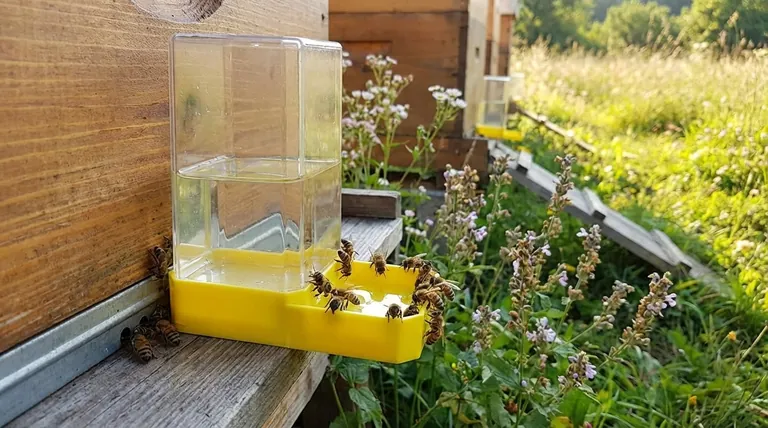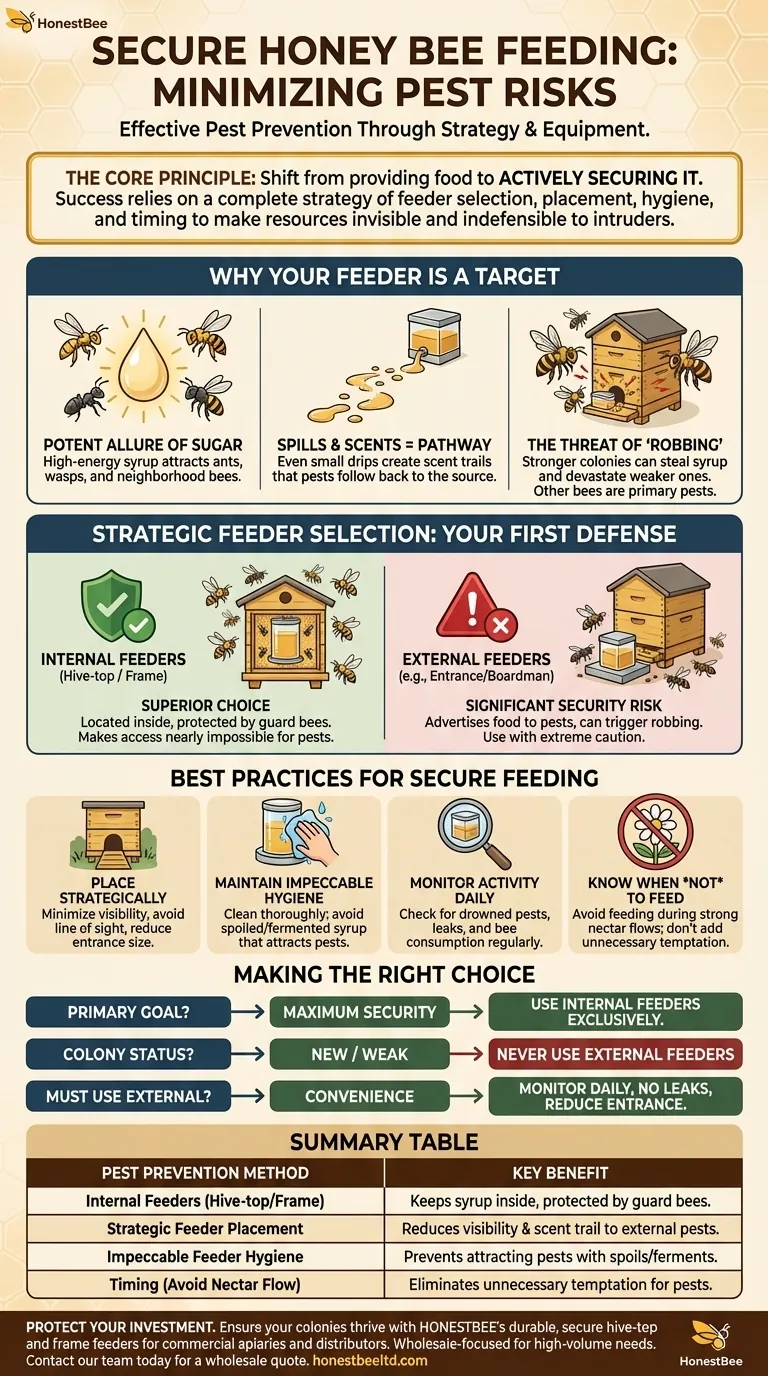To effectively minimize pests when feeding honey bees, you must make the syrup inaccessible to outsiders. The most reliable methods are using internal feeders, such as hive-top or frame feeders, which keep the food source entirely inside the hive, and placing any external feeders strategically to reduce their visibility and scent signature to opportunistic pests.
The core principle of pest-free feeding is shifting your mindset from simply providing food to actively securing it. Success depends less on a single gadget and more on a complete strategy of feeder selection, placement, hygiene, and timing to make your colony’s resources invisible and indefensible to intruders.

Why Your Feeder is a Target
Any open food source in nature will attract competition. Understanding why your bee feeder becomes a hotspot for pests is the first step in protecting it.
The Potent Allure of Sugar
Sugar syrup is a high-energy, easily accessible food source. This makes it incredibly attractive not just to your bees, but also to ants, wasps, hornets, and even bees from neighboring hives.
Spills and Scents Create a Pathway
Even small drips or spills of syrup on or around the hive create a scent trail. Pests are highly adept at following these trails back to their source, leading them directly to your feeder.
The Threat of "Robbing"
"Robbing" occurs when bees from stronger, nearby colonies discover your feeder. They will steal the syrup and may even invade your hive, kill the queen, and decimate your weaker colony. In this context, other honey bees are a primary pest.
Strategic Feeder Selection: Your First Line of Defense
The type of feeder you choose is the most significant factor in preventing pest access. Your goal should be to keep the food source contained entirely within the hive's natural defenses.
Internal Feeders: The Most Secure Option
Hive-top feeders and frame feeders (also known as in-hive feeders) are the superior choice for pest control. Because they are located inside the hive, they are protected by the colony's own guard bees, making it nearly impossible for external pests or robber bees to access the syrup.
External Feeders: A Calculated Risk
External feeders, such as entrance or "Boardman" feeders, are convenient but represent a significant security risk. They advertise the food source to any pest in the area and can easily trigger a robbing frenzy. If used, they must be managed with extreme care.
Best Practices for Secure Feeding
Beyond feeder selection, your management practices are critical for keeping your feeding efforts secure and effective.
Place Feeders Strategically
If you must use an external feeder, place it in a location that minimizes its visibility. Avoid placing it directly in a line of sight from other hives. Reducing the hive entrance also helps your bees defend their home from intruders.
Maintain Impeccable Hygiene
Clean your feeders thoroughly with hot water between uses. Spoiled or fermented syrup is unhealthy for your bees and can attract different types of pests, like ants and small hive beetles.
Monitor Feeding Activity Daily
Check your feeders regularly for drowned pests, signs of leakage, and bee activity. If your bees aren't consuming the syrup, it may be spoiled or indicate a larger colony health issue.
Know When Not to Feed
Avoid feeding when there is a strong natural nectar flow. Unnecessary feeding adds excess moisture to the hive and provides a tempting target for pests when your bees are busy foraging elsewhere.
Making the Right Choice for Your Goal
Your approach to feeding should align with the specific needs and strength of your colony.
- If your primary focus is maximum security and pest prevention: Use internal hive-top or frame feeders exclusively to keep the syrup protected within the hive.
- If you are supporting a new or weak colony: Never use an external feeder, as it makes the colony a prime target for robbing by stronger hives.
- If you must use an external feeder for convenience: Monitor it daily, ensure there are no leaks, and reduce the hive entrance to a size your bees can easily defend.
Ultimately, a proactive feeding strategy ensures the nourishment you provide strengthens your colony, not the pests that threaten it.
Summary Table:
| Pest Prevention Method | Key Benefit |
|---|---|
| Internal Feeders (Hive-top/Frame) | Keeps syrup inside the hive, protected by guard bees. |
| Strategic Feeder Placement | Reduces visibility and scent trail to external pests. |
| Impeccable Feeder Hygiene | Prevents attracting pests with spills or fermented syrup. |
| Timing (Avoid Feeding During Nectar Flow) | Eliminates unnecessary temptation for pests. |
Protect your investment and ensure your colonies thrive with the right equipment. HONESTBEE supplies durable, secure hive-top and frame feeders designed for commercial apiaries and distributors. Our wholesale-focused operations provide the reliable, high-volume supplies you need to implement a pest-minimized feeding strategy. Contact our team today to discuss your beekeeping equipment needs and request a wholesale quote.
Visual Guide

Related Products
- Professional Hive Front Entrance Bee Feeder
- Boardman Entrance Bee Feeder Durable Galvanized Steel and Wood Construction for Beekeeping
- Classic Boardman Entrance Bee Feeder Hive Front Feeding Solution
- HONESTBEE Professional Entrance Bee Feeder Hive Nutrition Solution
- HONESTBEE Entrance Bee Feeder Efficient Hive Front Liquid Feeding Solution for Beekeeping
People Also Ask
- How does a beehive entrance feeder work? A Simple Guide to Supplemental Feeding
- Are entrance feeders good for bees? Prioritize Hive Health Over Convenience
- How to make an entrance feeder for bees? A DIY Guide for Safe & Effective Feeding
- How is the mesh ladder and barrier installed in the feeder box? A Step-by-Step Guide to Prevent Bee Drowning
- How does the entrance feeder method work? A Guide to Simple But Risky Hive Feeding



















